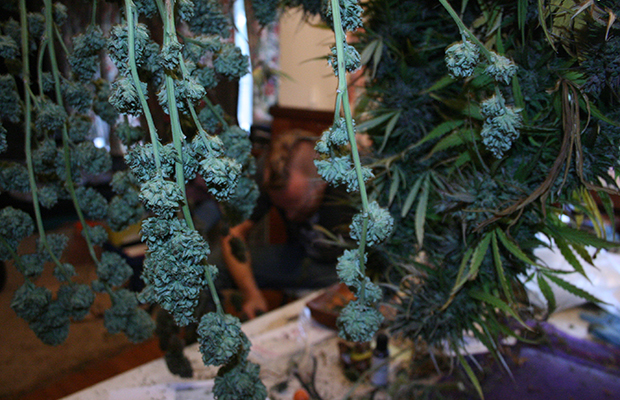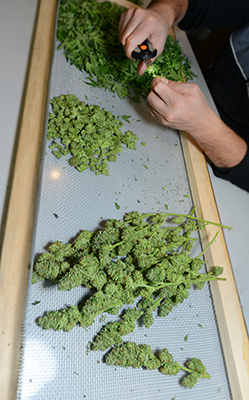Ganja Stylist: The Secret World of Trimming
Needless to say, trimming is a stoner’s dream job. Still, a serious ganja stylist treats trimming like real work.
Harvest season in Northern California is a remarkable time of year. The leaves are a rainbow of autumn colors, the air is cool and crisp, summer comes to San Francisco and the psychedelic excess of festival season gives way to a mellow reconnecting with the bounty of the land. It also marks the beginning of trim season and the annual emergence of a unique cannabis subculture, a sort of underground aspect, of the pot world.
Rumors of nomadic tribes of hippies, travelers and artists who spend harvest season trimming their way across Northern California via word-of-mouth connections – sometimes in opulent mansions with catered food and on-site massage therapists – may, at first, sound like mere fantasy. Indeed, tales of earnings upwards of $20,000 per season — which trimmers purportedly use to do things like finance ambitious world travel plans, produce art and music or subsidize college tuition — are as plentiful in this region as they are fanciful.
But, to call them “trimmers” would be missing the mark. They are more like ganja stylists. They make cannabis beautiful. Using special scissors and a keen eye for aesthetics, they cut away the leaves until only the bud remains. With skillful precision, they meticulously employ specific trimming techniques uniquely suited to each strain. Considering the fastidiousness that goes into transforming homely weed that has been languishing in the elements into sparkling nuggets of one of California’s largest cash crops, trimming isn’t merely a vocation; it’s an art form.

However, unlike many forms of art, this one actually pays. The standard rate for trimmers is around $200 for every pound of finished product, although for strains that don’t weigh much or for very small buds that are more tedious to trim, that price can go up to $300 per pound. With pot prices on the decline, however, the lower end of that spectrum is far more common. A steadfast worker can trim a pound in six hours, so earning $400 a day is not unheard of. For a stylist on a farm that does massive production, work can last up to three months or more, which means hanging out and trimming weed all day could translate to $10,000 in a single month – paid in cash.
Even though all the trim scenes I worked in were absolutely legal according to California state law (with cannabis grown for medicinal use by and for people with medical marijuana recommendations) the fact that cultivation is still illegal at the federal level makes it not worth the risk for growers to hire people they don’t know or who their trusted friends can’t vouch for. That makes trimming an exclusive club of very fortunate gypsies.
By all accounts, trimming is like summer camp for pot heads. Typically, trimmers hang out at a house and sit around a central table, steadily styling freshly-cut cannabis. Sometimes this can take weeks, sometimes months and other times just days, all depending on the size of the operation and whether the grower decides to suddenly close shop and go to Burning Man. As a rule, the grower provides room and board for the duration, so some stylists just go from scene to scene, skipping the burden of paying rent all season long while earning enough funds to maintain a humble lifestyle until next season.
Trim scenes can range from rustic to opulent. Some set-ups offer trimmers little more than a place to pitch a tent and access to minimal facilities powered by generators, somewhere deep in the woods with no cell reception. But some growers hire chefs and massage therapists, making trimming the most luxurious job most hippies will ever have.
A Dream Job
At my first location, I was in a comfortable house with all the basics. The proprietor cultivated cannabis on behalf of chronically ill and sometimes terminally ill patients who were members of his Los Angeles dispensary. We were fed gourmet, vegan food and never ran out of organic munchies. Around the trim table, we pondered the law of attraction, government conspiracies and UFOs, all while listening to bass-heavy electronic music, paranormal radio, punk rock and Donovan songs.
More determined trimmers severely limit their cannabis intake to maintain a high level of productivity, while others turn off their phones to diminish distractions. The most tenacious among them work until they can’t keep their eyes open, then nap only long enough to have the energy to get right back to it – usually pulling 18-hour days. Still others view the act of trimming as a sort of meditation, snipping at a slow and steady pace.
Being a ganja stylist was a job I took seriously. I worked not to be the fastest, nor to earn the most money: I worked to reveal the most gorgeous manifestation of every bud. When I walked out of my first gig, I had earned a fat wad of cash, been tipped a big bag of buds and the grower was so impressed that he wrote me a letter of recommendation. Not a trimmer, a ganja stylist. But like all trimming gigs, this one would soon come to an end.
A few days in, I received an urgent call saying a series of misty nights had left a crop under threat of mold. The collective cultivating the buds needed trimmers immediately. The situation was so dire that he offered to pay the $150 cab fare to get me there, as well as any friends I wanted to bring. I headed up the following morning with someone I’d invited just a few hours earlier; an industry so reliant on Mother Nature requires such flexibility. It would turn out to be the cushiest scene of my pot styling career.
My new home was a $2.8 million mansion less than a mile from California’s incomparably beautiful Mendocino coast that the grower rented just for his trimmers to trim in. All the bedrooms had their own bathroom with Jacuzzi tub. There was a hot tub under the stars, a heated salt water lap pool, two steam rooms and a cedar sauna. My new boss was a former professional chef who stocked exclusively organic products. But, between the time I was invited and the time I arrived, things had changed. The entire staff, including the one who invited me, had been unceremoniously fired from the project hours before – evidence that despite pot’s reputation as a peace-inspiring plant, trim scenes are not immune to drama. But I came to work and there was plenty of it. After the impressive tour, I was handed the scissors and told to help myself to anything I desired.
This scene had limits on how many hours a day trimmers could work, a rule designed to preserve the health and well-being of even the most ambitious stylists. But again, it was not to last. The very next day, the grower put the project on hold for a few days while he attended a festival. In this business, trimmers don’t wait around a few days; they go find the next job. To be sure, this lifestyle is not for everyone. Ganja stylists are at the mercy of the grower and must be ready at all times for anything, including nothing at all.

A Tight Knit Group
Camaraderie is so strong in this exclusive subculture that when a project ends, trimmers commonly help each other find the next assignment. In fact, it’s one of the only ways stylists progress from one pot farm to the next, since news of such work is spread only by word-of-mouth. They also offer up the occasional warning. Apparently, a telltale sign of how well a grower takes care of his trimmers is whether he shops at health food stores.
“You don’t want to trim for that guy,” one advised. “He shops at Safeway.”
My third and final gig of the season began spontaneously at an after-party for a local concert. I woke there the next morning to an offer to stay and trim, but only for that day, as other trimmers were en route and they wouldn’t have room for me after. But within hours, an expected trimmer backed out of her commitment to work, leaving an open space for me. I accepted easily because, like any prepared ganja stylist, I kept my backpack packed and my belongings with me, ready to go or stay at a moment’s notice.
I worked there another week in what turned out to be the most inspiring trim experience of them all. On a superficial level, it was the most rustic of the three scenes: I went from a mansion with Jacuzzis and a sauna to camping with an outhouse and outdoor shower. But there’s no doubt about which I preferred. Every trimmer there felt like instant family. They were artists of every shade – singers, musicians, painters, photographers, writers, dancers, fashion designers, jewelry makers – and hailed from places around the globe: London, France, India, Australia, Israel, Puerto Rico and Costa Rica. I felt like I’d just been inducted into some rag-tag United Nations joint task force.
The growers were raw foodists and nutritionists who encouraged the trimmers to take yoga breaks and jump on the trampoline. We did “circle” (holding hands and offering gratitude) before every meal, all of which were raw/vegan like the chef they hired, who was likewise our massage therapist. The chef made frequent appearances in the trim room offering cannabis-infused raw chocolate, coconut bliss balls, raw chai and almond milk. When the moon was full, she made magic mushroom chocolates and we threw a party, invited friends and danced in the moonlight.
The Occasional Drawback
While it may sound like a cannabis lover’s ideal side gig, trimming as a vocation is not without its drawbacks. Some farms don’t produce buds sizable enough to translate to fat stacks. In addition, outdoor crops commonly get compromised by the elements, leaving moldy buds for stylists to trim and, by virtue of proximity, inhale. Trim work is also notoriously inconsistent. Lag time between assignments can be weeks, with no guarantee that future work will be obtained at all.
Far more common than the $10,000 a month mentioned earlier, are earnings of a few thousand dollars the entire season, hard-won after excruciating hours of tedious snipping. And many growers pay their trimmers out of the money they make recovering their operation costs, which means stylists can wait months to get paid, with no legal recourse if they don’t. Trimmers can even be arrested and charged along with the growers. Then there are those stylists who don’t earn as much as they hope to simply because when it comes down to it, they talk too much with their hands.
For hardcore ganja stylists, the risk, instability and uncertainty are all part of the adventure. Trim season will end, winter travels will commence, summer festivals will follow and the cycle will begin again underground, where trimming lives on as an urban myth that is more herb than myth.
Originally published in issue 13 of Cannabis Now. LEARN MORE.
TELL US, would you work in the cannabis industry?
























